INTRODUCTION
In large-scale industrial, commercial and ground mount PV plants, many inverter manufacturers mention Y-type terminals while promoting inverters. So what is a Y-type terminal and what impact can it bring to the cost reduction of a PV power station? Under what circumstances is it suitable to use the Y-type terminal? Let’s find out.
PART1
Y-type terminals
01. Common Y-type Terminals
The Y-type DC terminal is a special connector for photovoltaic plants. It is mainly used for the circuit connection between the outdoor solar panel and the inverter/combiner box. It's function is to connect 2 PV strings in parallel to 1 circuit. Benefits are UV resistance, abrasion and aging resistance, and it's outdoor service life is up to 25 years. Common Y-type terminals are shown in the figure below, which can be equipped with or without fuse(s) as required.
02. Y-type Terminal Usage
On the market, the mainstream string inverter MPPT has two DC inputs,
We can use Y-connector to connect two PV strings parallel into one string, and then connect to one of the DC input ports of MPPT, which can reduce the number of DC cables to saving costs.
There are two schemes for MPPT inverters with two DC inputs: one Y-connector + one normal string or two Y-connectors. The specific schematic diagram is as follows:
02. Y-type Terminal Usage
On the market, the mainstream string inverter MPPT has two DC inputs,
We can use Y-connector to connect two PV strings parallel into one string, and then connect to one of the DC input ports of MPPT, which can reduce the number of DC cables to saving costs.
There are two schemes for MPPT inverters with two DC inputs: one Y-connector + one normal string or two Y-connectors. The specific schematic diagram is as follows:
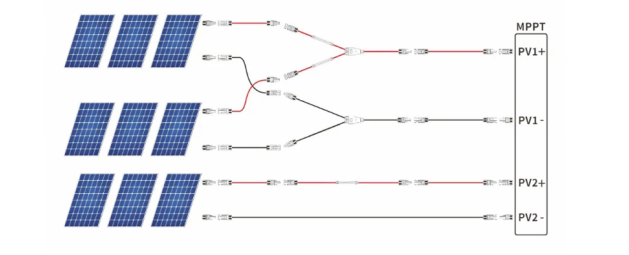
one Y-connector + one normal string
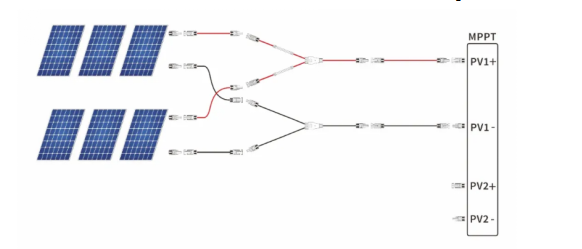
two Y-connectors
PART2
Analysis of MPPT three-in-two scheme
01. Solution Advantages
In C&I projects, in the past, limited by the power of the components and the number of input channels of the inverter, the Y-type terminal can play a role in improving the capacity ratio. For example, conventional 166mm modules, using Y-type terminals can connect the MPPT designed as two-channel DC input to three strings through the 'Y+1' method, thereby improving the capacity ratio. In the case of the same DC side capacity, take the over configuration of 1.5 as an example, and compare it with the traditional wiring scheme of unused Y-type terminals. If the on-site construction costs and the cost of auxiliary materials such as bridges are included, the main equipment costs and the line cost can actually be reduced by 32.3%. See the table below.
Main equipment cost difference table (take 10MW project as an example)
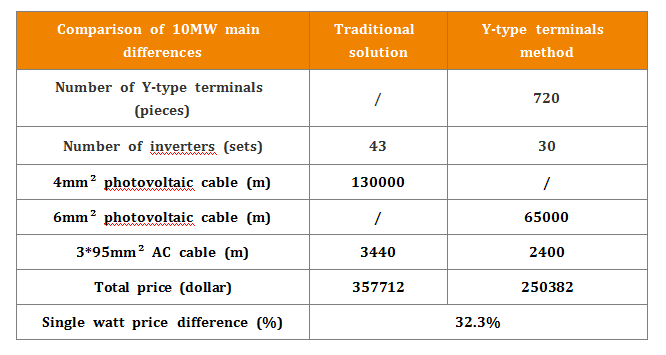
02. Project Impact
After the Y terminal is used, the risk of poor contact and poor insulation will increase due to the increase of DC contact points. At the same time, a fuse needs to be installed due to the increase of the DC input current, which brings about the problem of fuse failure maintenance and increases the complexity of O&M. In the final design, it is necessary to set the capacity ratio according to the project site to ensure maximum system revenue.
03. Practical Applicability
Now with the increasing power of modules, conventional 166mm modules will gradually disappear from C&I and large ground mount PV plants in the future. The mainstream in the market will become 182mm and 210mm monocrystalline modules. Therefore, with the exception of individual manufacturers who are limited by the number of inverter inputs, the Y terminal will be less used for upgrades when using small-sized components of 166mm and below or high capacity ratio (>1.3).
Taking Solis as an example. In the future, when using high-power solar modules of 182mm and above, Solis GCI-230K-EHV has 12 MPPT, 24 inputs, supports up to 24*15A current input, and is perfectly compatible with high-power and bi-facial solar modules. It can still achieve an over configuration of 1.5x or more without using the Y-type terminal. It is the first choice for cost reduction and efficiency enhancement of large PV plants. A plan is shown in Table 2 below. When using components of 166mm and below, Solis has 28 input products to choose from, and the capacity ratio can still meet the requirements without the Y-type terminal.
GCI-230K-EHV and 182mm module adaptation scheme
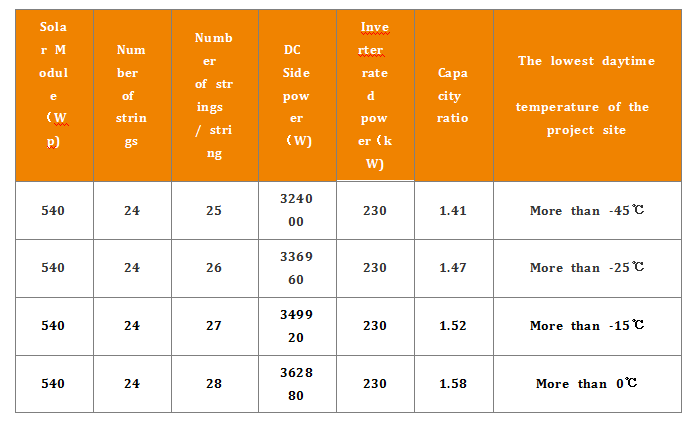
Note: 540Wp bifacial module considers 10% back gain is 594Wp, open circuit voltage is 49.5V, working current is 14.3A.
PART3
Analysis of MPPT two-in-one scheme
Another application of the Y terminal is to reduce the cost of the DC cable by adopting the MPPT two-in-one scheme, which is analyzed below.
01. Solution Advantages
Select high-power modules and inverters for large-scale PV plants on the market for analysis. Choose 182mm double-sided mono 540Wp module (peak power current 14.30A). Select Solis GCI-230K-EHV (each MPPT maximum input 30A). Using Y-shaped terminals, the original single MPPT two 4mm² photovoltaic cable inlets are integrated on the string side into a 6mm² photovoltaic cable inlet. Taking a 10MW project as an example, the cost of photovoltaic DC cable is reduced by 32.8%.
Photovoltaic cable cost comparison (take 10MW project as an example)
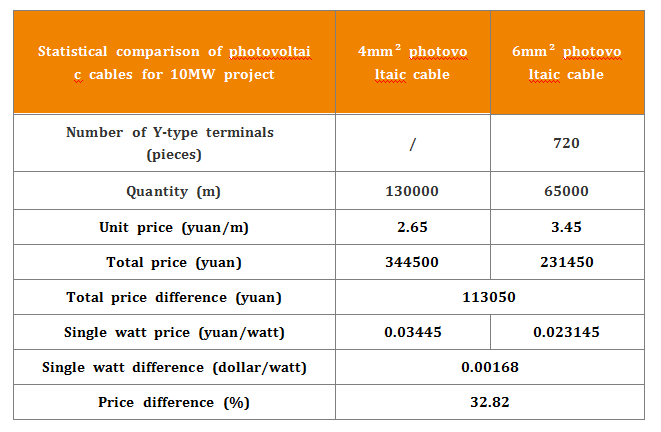
02. Project Impact
After the Y-type terminal is adopted, although the cost of the DC cable can be reduced, the original string-level monitoring will become MPPT-level monitoring, which loses the advantages of the original string-level monitoring and has an impact on intelligent monitoring and O&M. Therefore, it is necessary to comprehensively consider whether to use the Y terminal from the perspective of economic & ongoing operating decision point.
03. Practical Applicability
For ground mount PV plants, although string inverters on the market allow Y-terminal access, they are limited by the maximum input current of MPPT (currently 30A in mainstream large PV plants) and only support 2 strings. The peak power of mainstream modules of 182mm and above is 14A+. In this case, use the Y terminal to connect to one of the inputs of the MPPT circuit. The MPPT single-string interface supports 30A.

PART4
Conclusion
This article introduces the Y terminal and its application in industrial, commercial and ground mount PV plants. We have analyzed the advantages, impacts and practical applications of different solutions through specific cases.
It is concluded that in the application of conventional power modules, the use of Y-type terminals can solve some problems; such as that the capacity ratio cannot be increased due to the insufficient number of inverter input channels, and can save the cost of photovoltaic cables in the system and save the cost of inverter and AC outlet to varying degrees.
However, its drawbacks, such as the loss of cascade-level monitoring, the increase in operation and maintenance costs, loss of power generation, and the maintenance of external fuse failures, should not to be ignored. What to choose in actual application depends on the site conditions.

 中国
中国
 India
India
 Việt nam
Việt nam
 Australia
Australia
 대한민국
대한민국
 پاکستان
پاکستان
 ประเทศไทย
ประเทศไทย
Filipino
 Malaysia
Malaysia
 Bangladesh
Bangladesh
 Sri Lanka
Sri Lanka
 Indonesia
Indonesia
 Узбекистан
Узбекистан
 Ireland
Ireland
 Česká republika
Česká republika
 Türkiye
Türkiye
 United Kingdom
United Kingdom
 France
France
 Deutschland
Deutschland
 Nederland
Nederland
 España
España
 Sverige
Sverige
 Italia
Italia
 Polska
Polska
 Україна
Україна
 Português
Português
 България
България
 Magyarország
Magyarország
 Lietuva
Lietuva
 Ελλάδα
Ελλάδα
 Suomen tasavalta
Suomen tasavalta
 United States
United States
 Canada
Canada
 México
México
 Brasil
Brasil
 República de Chile
República de Chile
 South Africa
South Africa
 المملكة العربية السعودية
المملكة العربية السعودية
 الجمهورية اللبنانية
الجمهورية اللبنانية
 امارات عربية متحدة
امارات عربية متحدة
 اليمن
اليمن
 المملكة الأردنّيّة الهاشميّة
المملكة الأردنّيّة الهاشميّة
 جمهورية مصر العربية
جمهورية مصر العربية
 la République Tunisienne
la République Tunisienne
 Kenya
Kenya
 Tanzania
Tanzania
 Nigeria
Nigeria
 Other Countries and Regions
Other Countries and Regions









